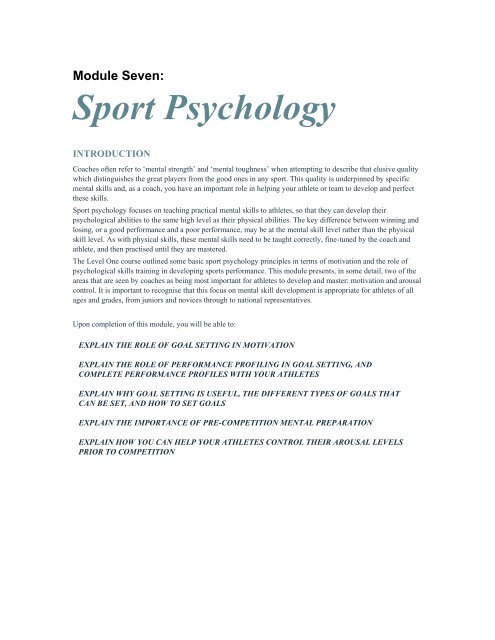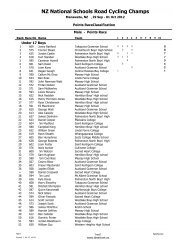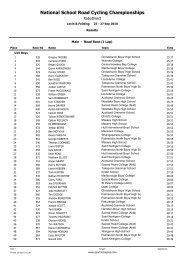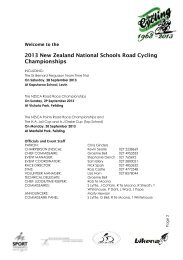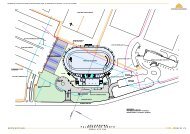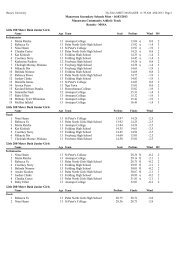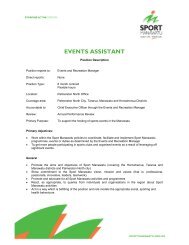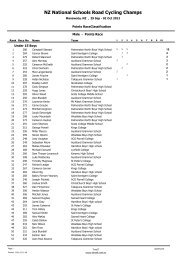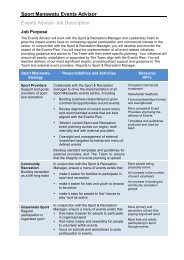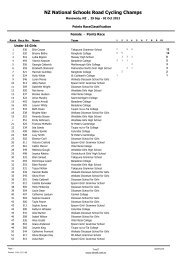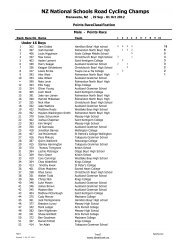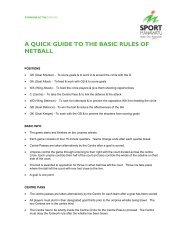Module Seven: Sport Psychology - Sport Manawatu
Module Seven: Sport Psychology - Sport Manawatu
Module Seven: Sport Psychology - Sport Manawatu
Create successful ePaper yourself
Turn your PDF publications into a flip-book with our unique Google optimized e-Paper software.
<strong>Module</strong> <strong>Seven</strong>:<strong>Sport</strong> <strong>Psychology</strong>INTRODUCTIONCoaches often refer to ‘mental strength’ and ‘mental toughness’ when attempting to describe that elusive qualitywhich distinguishes the great players from the good ones in any sport. This quality is underpinned by specificmental skills and, as a coach, you have an important role in helping your athlete or team to develop and perfectthese skills.<strong>Sport</strong> psychology focuses on teaching practical mental skills to athletes, so that they can develop theirpsychological abilities to the same high level as their physical abilities. The key difference between winning andlosing, or a good performance and a poor performance, may be at the mental skill level rather than the physicalskill level. As with physical skills, these mental skills need to be taught correctly, fine-tuned by the coach andathlete, and then practised until they are mastered.The Level One course outlined some basic sport psychology principles in terms of motivation and the role ofpsychological skills training in developing sports performance. This module presents, in some detail, two of theareas that are seen by coaches as being most important for athletes to develop and master: motivation and arousalcontrol. It is important to recognise that this focus on mental skill development is appropriate for athletes of allages and grades, from juniors and novices through to national representatives.Upon completion of this module, you will be able to:EXPLAIN THE ROLE OF GOAL SETTING IN MOTIVATIONEXPLAIN THE ROLE OF PERFORMANCE PROFILING IN GOAL SETTING, ANDCOMPLETE PERFORMANCE PROFILES WITH YOUR ATHLETESEXPLAIN WHY GOAL SETTING IS USEFUL, THE DIFFERENT TYPES OF GOALS THATCAN BE SET, AND HOW TO SET GOALSEXPLAIN THE IMPORTANCE OF PRE-COMPETITION MENTAL PREPARATIONEXPLAIN HOW YOU CAN HELP YOUR ATHLETES CONTROL THEIR AROUSAL LEVELSPRIOR TO COMPETITION
EXPLAIN THE ROLE OF GOAL SETTING IN MOTIVATIONBefore you begin, think about the following points:• What motivates the athletes you coach?• How can you, as a coach, best meet the needs of your athletes at training and competition, andconsequently keep them involved in sport?INTRODUCTIONCoaches are always interested in learning ways to help their athletes motivate themselves. Athletes are concernedwith maintaining their motivation once they have acquired the drive and desire to succeed at their sport.Motivation is a complex concept involving the combination of direction and intensity of effort in a particularsituation. For example: direction – playing for a team or club, attending a coaching clinic or aerobics class,joining a fitness centre, or seeking physiotherapy treatment for an injury: intensity – the amount of effort withwhich an athlete pursues their chosen direction (Weinberg & Gould, 1995).PARTICIPATION IN SPORAthletes participate in sport for three main reasons:• fun – enjoyment, challenge and excitement,• socialisation – to be with others, belonging to a group, and• self-esteem – achievement.Understanding why athletes participate is an important key to motivating them. It may be useful for you to askyour athletes to complete a simple exercise at the start of each season or period of coaching, rating themselves 1to 10 on each of the aspects above. If the participation needs of your athletes are not being met, these becomegoals you can help your athletes work towards achieving.It is important that your goals and those of your athletes are compatible. If you want to win the regionalchampionship, and your athletes just want to play for fun and socialisation and are not prepared to put in theeffort required to achieve your goal, conflict will inevitably result.GOAL SETTINGGoal setting has been shown to influence the performance motivation of athletes of varied ages and ability levels,and has also been linked to positive changes in important psychological states such as anxiety, confidence, andself-concept. It is a basic technique that coaches, athletes, sport psychologists and allied sport professionalsshould regularly employ.Goal setting is primarily a mental skills technique used to generate, enhance, and maintain motivation.Goal setting achieves this by:• organising the existing needs, desires and objectives of your athletes, i.e. their goals,• creating a focus of attention and action, and• identifying what the athletes and coach are trying to do or accomplish. This provides a purpose for theathletes’ efforts.
Once you have identified common goals with your athletes, you need to work together to decide upon a plan ofaction to achieve or accomplish those goals. This allows you to make the most efficient use of training time inorder to maximise performance and enjoyment.Goals can be viewed as the regulators of motivation. Therefore, the importance of establishing a goal settingprogramme cannot be overstated. However, like other mental skills, goal setting is not a magic formula thatguarantees success. Goal setting is a very effective tool that, when combined with hard work, can help athletesreap the fruits of personal growth and peak sporting performance.QUESTIONS & EXERCISESExplain factors that can cause an athlete’s motivation for sport to increase or decrease over time.EXPLAIN THE ROLE OF PERFORMANCE PROFILING IN GOAL SETTING, ANDCOMPLETE PERFORMANCE PROFILES WITH YOUR ATHLETESPERFORMANCE PROFILESPerformance profiles are a means for you to assess where your athletes are now, and the standard of performancethey are trying to achieve. From this the improvements required to achieve their target performances can bedetermined. Performance profiles:• identify the needs and key requirements of your sport,• identify the qualities and skills your athletes need to work on,• allow you and the athletes to set goals, and plan training to improve performance and achieve targets,• allow your athletes to build up a picture of themselves, which helps build confidence and self- esteem,• help create a greater understanding between you and your athletes, and• help develop team work and team spirit.USING PERFORMANCE PROFILESThere are four steps to completing a performance profile.1. Identify the important qualities required by your sport. You could do this with individual athletes, or in agroup through discussion. These qualities generally fall into four main areas.These are:• Psychological – mental skills,• Tactical – strategies, patterns and tactics used in your sport,
• Technical – specific physical skills required in your sport, and• Physical – fitness requirements of your sport (speed, strength, endurance, flexibility).The weighting placed on these qualities varies in different sports and with different individuals.2. Rate each athlete on the qualities that you identified. Rate where the athletes are at now, and their targetperformances, i.e. the standard they are trying to achieve.3. Rate the qualities that need improvement and the extent of the improvement required by each of your athletesto achieve their target performances (1 = huge improvement required, 10 = no improvement possible).4. Develop goal setting programmes with the athletes to make the improvements required to achieve their targetperformances. Quantify the goals using the ratings from their performance profiles, e.g. increase performanceof a particular skill from 6 to 8.Repeated profiling enables you to measure your athletes’ progress, which can be particularly important whenathletes are peaking for an important event.An example of a performance profile is included on the following page. Use this as a guide only and do not feelrestricted to the size of the page. Write down a full list of the essential requirements of your sport, prioritisethese, and include the top three or four on the performance profile.QUESTIONS & EXERCISESExplain the concept of performance profiling and how it forms the basis of goal setting.Write down your own long-term coaching goals.Assess your own abilities as a coach, using the Performance Profile Sheet provided as a guide. Youneed to identify your strengths and weaknesses, and the areas you need to focus on over the next 12months.(Considering the same questions you will be asking of your athletes will help you gain a goodunderstanding of how challenging the issue of long-term goals can be. You should then go throughthe performance profiling process yourself, to get a feel for it.)Choose one athlete who you currently coach, and profile that person’s performance level, using thePerformance Profile Sheet provided as a guide. You need to consider the areas of the athlete’sperformance that would most benefit from a specific goal setting programme. Complete thePerformance Profile Sheet in consultation with your athlete.PERFORMANCE PROFILEComplete this form.Quantify factors where you are able to do so. Use a 1 to 10 scale (1 poor, 10 excellent) for factors which areunable to be quantified. State your current position, target performance, and the improvement required to achieveyour target performance.From these results work with your coach to develop and implement a goal setting programme designed toachieve your target performance.
NameDateFactorsCurrent PerformanceTarget Performance ImprovementPsychological• concentration••••Tactical•••••Technical•••••Physical•••••
EXPLAIN WHY GOAL SETTING IS USEFUL, THE DIFFERENT TYPES OF GOALS THATCAN BE SET, AND HOW TO SET GOALSWHY SET GOALS?Goals:• help maintain motivation by reflecting improvement,• help determine what is important to athletes – they give direction, and force athletes to prioritise their needs,• help improve performance – show athletes their strengths, and those areas requiring development,• help focus attention and effort, and• provide feedback on performance.WHAT TYPE OF GOALS SHOULD WE SET? – ‘CONTROLLING THECONTROLLABLES’In all sports, there are elements that are controllable and others that are uncontrollable.For example, Freda is a pace bowler who has set herself a goal of taking 17 wickets in a tournament in which herteam is competing. (This is an example of an outcome goal over which Freda does not have full control.)Uncontrollable Elements• Fielders.• Pitch.• Weather.• Batters (has some control, but certainly not total).• Selectors.• Captain (decides when and if Freda bowls).Controllable Elements• Where she puts the ball.• What the ball is doing.• Her own commitment and effort.• Her concentration.• Tactics.For every outcome goal an athlete sets, they should set several performance goals to be achieved on the way toattaining the outcome goal. These should relate to elements over which the athlete has control.If Freda perseveres and achieves her performance goals, she will give herself the best possible chance to achieveher outcome goal, i.e. the 17 wickets. This is not to say that athletes should not set outcome goals, but they mustunderstand that there are many uncontrollables. Focusing on outcome goals creates anxiety, which is detrimentalto performance. It is far healthier psychologically to set performance goals which focus on the controllableelements. Some days, Freda may achieve her performance goals and not take any wickets, but mostly, if sheachieves her performance goals, she will also take wickets. At all times, she should focus on ‘controlling thecontrollables’, e.g. swinging or spinning the ball and putting 11 out of 12 balls where she wants to.
GUIDELINES FOR SETTING GOALSSet Performance Goals and Outcome Goals• Winning and losing are important, especially for more elite athletes, but winning and losing are not alwaysgood measures of improvement or personal ability and skill, and are not the only or best measures of success.Athletes normally have more control over their own performance than they do over outcomes.Set Long-Term as Well as Medium and Short-Term, and Daily Goals• Long-term goals provide direction over a long timeframe as you progress towards the ultimate objective ortarget.• Medium and short-term goals allow for periodic review of improvement, add reward for ongoing effort,and help to maintain motivation at key points during the season.• Daily goals allow athletes to break larger medium and short-term goals down to fit the resources (time,money, etc.) they have available to work towards their goals at any given time.The timeframes used to determine what is long, medium and short term will depend on the sport and the level atwhich the athlete is participating, i.e. club, regional, national, international.
Set Specific Measurable Goals• Numerical goals are easier to measure and evaluate success in reaching a goal.• Specific goals are very specific, detailed goals which are easy to measure and observe.For example:Poor goal: I want to be a fitter rugby player.Good goal: Since I am an outside back, I need speed and power – I want to reduce my timefor 50 metres by one second.Poor goal: I want to be a better goal shooter.Good goal: I want to be able to make six out of 10 attempts from within two metres.Areas in Which to Set Goals• Fitness – aerobic (endurance), anaerobic (speed).• Physical skills.• Mental skills – motivation, preparation, concentration, arousal control, etc.• Strength/Weight – weight training, diet.• Fun – plan for satisfaction and enjoyment. It is hard to be specific and numerical, but fun is worth aiming for.• ‘Life’ goals, linking these to sporting goals.Goals Must be Difficult to Reach but Realistic• Athletes need to know their own limitations and abilities.• Goals should be difficult enough so their achievement has value, but still close enough so they can beachieved with honest effort, in the timeframe the athlete specifies.Goals Must be Prioritised• At any one time, athletes may be working on more than one goal. Therefore, they need to know which one ismost deserving of their efforts if they cannot attend to all of them.• In this case, reference to their performance profiles will allow them to target what their priorities should be.
Each goal can be broken down into smaller goals (short-term or daily) to show progress. Each larger goal canhave its own ‘staircase’ of smaller goals. An example is illustrated, see Figure 1.Goals Must be Flexible• Flexibility is not ‘copping out’. Athletes may need to change either, (i) their goals, or (ii) their timelines, forany one or more of a number of unforeseen circumstances, e.g. illness or injury.• Athletes may need to change the time schedule for goal attainment, if the goals set are either too easy or toodifficult to achieve.HOW TO SET GOALSAthletes need to talk to their coach and answer these key questions.• Where am I now?• Where do I want to be in one week, next month, six months, two years?• What are my strengths?• What areas need development?Athletes Need to Prioritise their Needs and Select Two or Three GoalsThese goals should:• include long-term and short-term goals,• be hard but realistic, and• have a date set for achievement.Athletes Need to Outline a Strategy to Achieve their Goals
The strategy needs to be specific; e.g. Anaerobic Fitness Goal Strategy: I will do 30 minutes’ extra sprint workon non-practise days (Mon/Wed). I will find a training partner to maintain my effort and motivation. I will do 10x 20m, 10 x 50m, and 5 x 100m sprints.Athletes Need to Make a Firm Commitment to Achieve their GoalsThey need to:• ask themselves if they have the desire to pursue their goal achievement strategies,• be honest with themselves, and• write a contract with themselves.MONITOR GOAL SETTINGPursuing the set goal is the athletes’ task. Monitoring progress towards the goals set may also be the athletes’task, or may be done in consultation with the coach.Athletes Need to Write Down their GoalsThey should record:• both long-term and short-term goals,• their strategies for achieving their goals with targeted dates, and• goal evaluation procedures.Athletes Need to Remind themselves of their GoalsThey could:• maintain a training diary or log, or• make a wall poster of their goals.Athletes Need to Ask themselves Periodically:• what did I do today to become a better athlete?
EVALUATE THE GOALSAthletes Need to Evaluate their Goals PeriodicallyThey need to:• check goal attainment progress,• check target dates, and• check goal strategies.QUESTIONS & EXERCISESExplain why we set goals and the different types of goals that we can set, using your own sport as anexample.Following the guidelines presented in this module, set some specific, measurable goals for the athletefor whom you completed the performance profile. Rank these goals and put them into a timeframe.You will need to complete this in consultation with your athlete to ensure the goals are shared.PIRATES R.F.C.Goal Achievement ProgrammePlayer’s nameDateStrengthsWeaknessesLong-term rugby goals 123This season’s goals 123
EXPLAIN THE IMPORTANCE OF PRE-COMPETITION MENTAL PREPARATIONElite sporting performance requires peak levels of physical and psychological readiness. Athletes must plan toinclude mental skills in their training and practise programme. This means helping athletes develop strategieswhich allow them to enter competition with the proper mindset, and to perform consistently at their highest level.If athletes are interested in getting the most out of their sport, they can no longer treat their performance as acombination of isolated factors which come together in some mysterious and unified way on the day ofcompetition.‘PSYCHING UP’There is an ‘ideal performance state’ (thoughts, feelings, bodily responses) typically associated with peakperformance. The ultimate goal of mental skills’ training is for each athlete to consistently achieve the ‘idealperformance state’ at competition time. This will rarely occur if pre-competition preparation (the ‘psych up’),and the competition focus are left to chance, or if these are left in the control of others(e.g. coach, captain, parents). More often than not, individuals do not have a consistent pattern in readyingthemselves for competition (the ‘psych up’ procedures). Performance is likely to be improved if an individual’spreparation becomes more systematic. We seldom identify and systematically practise mental preparation skills.Yet, after the competition the greatest percentage of excuses are attributed to the mental and emotional aspects ofthe event!MENTAL WARM-UPThe mental preparation of the ‘countdown-to-competition’ ritual should consist of getting athletes physically andmentally ready for competition. Athletes need to develop a ‘mental warm-up’ to go with their ‘physical warmup’.This means monitoring and controlling emotions and thoughts so that the energy and excitement forcompetition build up slowly, without the individual becoming aroused (psyched up) too soon, or becoming soover aroused (psyched out) that feelings of anxiety and worry, rather than excitement and challenge occur.ACHIEVING CONSISTENCY IN PERFORMANCEAny athlete who participates competitively faces stressful situations and anxious moments hundreds of timesduring the course of their competitive career. For many, regardless of how many times they have been in thatsituation, they will still react in a negative way. Somehow, experience is not always the best teacher in this case!Individuals who are able to continue performing with some degree of consistency, despite their feelings ofanxiety, have learned to cope with this anxiety. Many athletes with superior physical capabilities have beensystematically eliminated from competitive sports because they could not perform with any consistency. They
might perform beautifully in practise, but ‘choke’ in competition. Consistent mental preparation is thus essentialfor peak performance. Once an athlete has learned to identify which mental, emotional and bodily states andfeelings accompany superior performance, they can learn to ‘programme’ these responses voluntarily in order toset the stage for another superior performance.Being psyched up, energised, wired, activated, aroused, or ‘ready’ is an integration of mind-body feelings andthoughts which provides the athlete with feelings of confidence, mastery, and control. Athletes can learn to reachthis state consistently by learning how to regulate their arousal level before and during competition.PSYCHOLOGICAL SKILL TRAINING: PRE-COMPETITION MENTALPREPARATIONThe following guidelines are recommended for use in teaching pre-competition mental preparation techniques toyour athletes.Psych Up or Psych Out? – Understanding Competitive StressCommon sayings about mental preparation are:• psych up, • psyched out,• fire up, • head case,• get psyched, • over motivated,• get motivated and, • choke.Psych up or psych out: what is the answer?The Fine Line Between Getting Up and Getting Uptight: The Relationship BetweenEmotional Arousal and PerformanceThe Emotional Arousal-Performance ‘Inverted “U” Theory’, see Figure 3.At low arousal levels, the performance of athletes will be less than optimum, i.e. they are not psyched up.As their arousal levels increase, their performance improves to a point where they perform at their best. If theathletes’ arousal levels continue to increase beyond this point, their performances begin to deteriorate.Key Points• Poor performance results if the athlete is under or over aroused.• Best performance results from optimal emotional and arousal states.• Optimal levels of arousal are sport and task specific (e.g. scrummaging vs. goal-kicking).• Each of us has a different optimal level of emotional arousal that will produce the best performance. You andyour athletes need to recognise when they are optimally aroused, over aroused and under aroused.• Motivational team talks must be planned carefully and used sparingly, as individual needs within a team varyconsiderably.
What Happens When an Athlete Becomes Over-aroused?When athletes choke, their attention-concentration shifts. They experience ‘tunnel vision’, and worry aboutworrying. There is an increase in muscle tension or tightness leading to decreased timing and coordination,and ‘paralysis by analysis’.QUESTIONS & EXERCISESExplain why pre-competition mental preparation is important in sport. Why not just go with the flow?Explain the difference between being ‘psyched up’ and ‘psyched out’.EXPLAIN HOW YOU CAN HELP YOUR ATHLETES CONTROL THEIR AROUSAL LEVELSPRIOR TO COMPETITIONCONTROLLING ATHLETE AROUSAL LEVELSOnce athletes have identified their optimal level of arousal for maximising performance, they can use appropriateenergising or relaxation techniques to increase or reduce arousal levels. All athletes need a certain amount ofarousal or motivation to perform well. However, this amount of arousal is specific to the individual, to the sportand even to specific skills within a sport. Some athletes require a higher arousal level than others to perform tothe same level.While being under aroused will lead to boredom and poor performance, too much arousal can be detrimental.Some individuals will respond positively to a highly charged emotional speech by the coach or captain, whereasothers may become over aroused and psyched out. Most coaches and athletes have tended to emphasise thepsyching up aspect of preparation for performance, while sport psychologists tend to focus on controlling, andoften lowering arousal.
During pre-competition mental preparation, and during competition itself, it is not uncommon for athletes toexperience feelings of worry, stress, and anxiety. Stress may be positive or negative, e.g. excitement causesstress. When an athlete’s concentration is adversely affected, the stress is negative. Feelings of stress and anxietymay be a result of pressure to perform from the coach, captain, spectators, or from the athletes themselves.Some stress is obviously useful in helping to energise an athlete to their desired level of arousal. However, toomuch stress, and an inability to regulate the over arousal it creates, will interfere with peak performance.In sport, we often call this ‘choking’ or being ‘uptight’. Mental errors, as well as tactical and skill executionerrors occur. Each athlete has to learn their own signs of over arousal resulting from anxiety, so that they can userelaxation skills to regulate their level of arousal. Our bodies provide us with a great number of warning signsthat we are becoming over aroused.Signs of Over ArousalSome of the signs of over arousal are listed in the table below. Obviously, if an athlete had all of these symptomsat once, complete dysfunction would occur! Most athletes have a personal combination of these signs when theyare anxious and over aroused. Individuals differ in how much their performance is affected by over arousal.Therefore, it is essential for athletes to identify the signs they associate with over arousal, and determine howthese signs influence their performance.
Immediate Physical or Somatic SignsCognitive or Behavioural Signs• Palpitations of the heart.• Muscle tension.• Sense of fatigue.• Dry mouth.• Clammy hands.• Butterflies in the stomach.• A desire to urinate.• Trembling and twitching in the muscles.• Flushed face, voice distortion.• Nausea and vomiting.• Yawning.• Hyperventilation.• Increased heart rate.• Increased respiratory rate.• A sense of confusion.• Irritability.• Forgetting details.• Inability to concentrate.• Inability to make decisions.• Self-doubts.• Fear.• Worry.Table 1. Signs of over arousal in athletes.Signs of Under ArousalWhen athletes are under aroused motivation is reduced. Their focus of attention is likely to be inappropriatelybroad and external, and they will be easily distracted. They may look and sound ‘flat’. Athletes who are underaroused will have trouble sticking to their pre-competition and competition routines because they cannot be‘bothered’. Their intensity or effort will be below that required for optimal performance.While a degree of relaxation is essential for successful performance, athletes who are under aroused clearly needa boost to their levels of motivation. Arousal levels may be increased by reminding athletes of the goals theywant to achieve. Short bursts of high intensity activity, upbeat, motivating music (e.g. from a walkman, probablyloud) and the use of exciting, powerful imagery are all techniques that are effective in raising an athlete’s arousallevel.QUESTIONS & EXERCISESYou need to recognise the signs that indicate an athlete’s mental preparedness for competition is ontrack. Using examples from your own experience, explain:• how you can tell if an athlete is too aroused or over anxious to achieve optimal performance, and• how you can tell if an athlete is under aroused or too relaxed to achieve optimal performance.CONTROLLING AROUSAL – THOUGHT CONTROLThought control involves getting rid of ‘stinking thinking’ and replacing it with ‘helpful thinking’. Athletes needto address their perceptions of and thoughts about a situation. ‘Stinking thinking’ focuses the athlete’s attentionon negative aspects of their performances, e.g. “Don’t panic!”, “Don’t worry about your injury”, or “Forget thatshe beat you last time”. Coaches often put these types of thoughts into their athletes’ heads. They are almostguaranteed to cause worry and anxiety, resulting in a poor performance. Such thoughts start a ‘negative thoughtcycle’.
Thought control involves interrupting this cycle by recognising negative thoughts and replacing them withpositive thoughts and expectations. It helps the athletes think or focus on the present, on things they can control.The quicker this is done, the better. It is common for athletes to allow negative thoughts to continue for sometime, because either they do not understand the detrimental influence they can have on performance, or they donot know how to manage them.EXAMPLE: TENNISStinking Thinking“Fred is fitter than me: if the match goes tothree sets, he’ll beat me for sure”Helpful Thinking- “I’ve worked hard for this match”- “I’m in good form”- “Keep that first serve going”For some athletes, if they are able to control their thinking, they can calm their body down. For others it worksthe other way; if they are able to calm their body down first, they can then control their thoughts. Hence, bodyrelaxation is an important skill for all athletes to develop.Thought control is a mental skill which requires practise. With help from their coach, or a sport psychologist,athletes who want to work at making changes need to:• understand that how they think affects how they feel,• write down the most common negative thoughts they have,• learn to recognise those negative thoughts in training and competition,• develop ways to stop those negative thoughts in their tracks,• write down some positive thoughts that they can use in different situations, and• practise converting their negative thoughts into positive thoughts.PSYCHOLOGICAL SKILL TRAINING – THOUGHT CONTROLThe following guidelines are recommended for use in teaching thought control skills to your athletes.The Sensory ApproachTo help your athletes develop the skills they need to do this, you should begin with a simple exercise.
This technique requires athletes to use their senses to reduce the effect of a negative thought. They canconcentrate on different features of the negative image in the following ways:• brightness: dim the negative image, and when the desired level is reached, replace it with a positive image,increasing the brightness until it is strong and dominant,• clarity: gradually blur the negative image and replace it with a progressively clearer and sharply focusedpositive image,• distance: slowly move the negative image further away and replace it with a positive image which comescloser and closer until it dominates,• size: progressively shrink the negative image, and then replace it with a positive image, enlarging this until itdominates,• colour: reduce the colour of the negative image until it is black and white, then replace it with a colourfulpositive image, and• sound: turn down the volume on the negative image and replace it with a positive image which increases involume.The Swish TechniqueThis technique requires athletes to:• identify the thoughts and images that occur in their minds just before they begin an action or behaviour thatthey would like to change,• see themselves as if they were watching themselves on a video performing the negative action or behaviour,and• create a big, bright positive image that they ‘swish’ across the negative image on the video screen, as if theywere using a big paint brush.With practise this may only take one or two seconds. Athletes should repeat the process four or five times and thepositive images will begin to stick in their minds.QUESTIONS & EXERCISESIdentify a common negative thought an athlete that you coach has and explain how you would helpthe athlete to change it.
CONTROLLING AROUSAL – STRESS MANAGEMENTWhat we think determines how we feel emotionally and how we subsequently behave. Stress occurs when thereis an imbalance between the physical and psychological demands placed on an athlete, and the athlete’s ability torespond to those demands, when they know failure to do so results in important consequences.• In the first stage, a physical and/or psychological demand is placed on the athlete.• Individuals perceive demands differently. One athlete will have little difficulty responding to the demand andwill not see it as a threat. Another athlete may see an imbalance between the demand and their ability to meetit, and therefore perceive the demand as threatening.• Where there is a perceived imbalance, there will be an increase in the athlete’s arousal level. This will resultin increased worries (cognitive state anxiety) and/or heightened physiological activation (somatic stateanxiety), and other reactions such as changes in concentration and increased muscle tension.• The increased arousal may improve the athlete’s performance, but it may also cause their performance todeteriorate. The behaviour exhibited by other athletes as a result of the stress response may add to the initialenvironmental demand. The stress process then becomes a continuing cycle.Example: BasketballA coach is teaching a young team how to shoot free throws and asks the players to take two shots each while the
est of the team line up around the edge of the keyhole.Some players may enjoy being the centre of attention for this short period of time, particularly if they feelconfident of their ability to make their shots. Others may feel less confident, and perceive the situation asthreatening. The increased arousal and subsequent reactions may improve the athlete’s performance, or it maymake them so tense that they miss the ring completely.If the rest of the team then laugh at her effort, this adverse reaction may place an additional demand on theplayer, making it even more stressful for her next time her turn comes around.QUESTIONS & EXERCISESIdentify and describe a common sporting situation that two athletes might perceive differently, andexplain why.CONTROLLING AROUSAL – RELAXATIONMost athletes find that over arousal is detrimental to peak performance and try to manage or regulate arousal totheir own optimal level. Learning to relax is essential to regulating these responses, to avoiding any detrimentaleffects on performance. When a muscle tenses up, as it does with worry and anxiety, it contracts or shortens.Proper form in any movement involves using a precise amount of tension in a muscle (or muscle group) – toomuch tension interferes with the execution of the skill. Athletes can learn to control their arousal levels andmuscle tension with the use of relaxation skills. Athletes need to be taught how to relax so they learn to avoid toomuch tension. Total relaxation means letting go and doing absolutely nothing with the muscles.You may wonder why any athlete would want to be completely relaxed. Athletes need muscular tension andarousal to perform; some need maximal tension to execute the skills of their sport. However, in learning to trainthe muscles to relax totally, athletes develop a much greater sensitivity to their own bodily feelings andresponses. Once athletes become aware of these bodily responses, and learn to associate them with peak levels ofperformance, they can learn to regulate their arousal levels and muscle tension using relaxation skills.Once trained in relaxation, athletes can use this skill to lower general muscular tension under any condition.Relaxation can assist in removing localised tension, such as that surrounding an injury. It can aid in the onset ofsleep, and can reduce insomnia problems that often afflict elite athletes. Relaxation can be used to regulate overarousal before competition (mental preparation), and during competition (momentary relaxation). Finally,relaxation is an essential skill in teaching athletes the advanced mental skill of imagery.PSYCHOLOGICAL SKILL TRAINING: STRESSMANAGEMENT/RELAXATIONThe following guidelines are recommended for you to use in teaching stress management/relaxation skills to yourathletes.What is Relaxation?Relaxation is a state where one is physically and mentally free from uncontrolled tension, anxiety and readiness.Purpose of Relaxation Training• Physiological calming of the body (decreased muscle tension, decreased heart rate).• Attention shift from anxiety-provoking thoughts to an increased state of relaxation.• Aids in achieving an optimal level of emotional arousal (refer to Mental Preparation notes).Why Learn Relaxation Training?• To help athletes achieve proper mental preparation (i.e. help achieve an optimal level of emotional readiness),before or during a competition.• To help athletes sleep the night before a major competition.
• As a mechanism for helping athletes develop concentration and imaging skills.Breathing Exercises for Immediate Relaxation – One Breath RelaxationThis is the most practical technique an athlete can learn. It is a quick technique which allows an athlete to take amomentary mind-body time-out or rest before refocusing. There are three steps to onebreath relaxation:1. Breathe in from the stomach and diaphragm.As they breathe in, they should imagine that all the muscles from the top of the chest, shoulders and jaw areloosening.2. Breathe out. As they breathe out, they should imagine that all excess tension is draining out through theirfeet, that their hamstrings have become loose, and that their feet are really light.3. Immediately refocus on the correct attentional cue, i.e. having completed the one breath relaxation, athletesmust direct their attention straight back to the task at hand.It is very important to practise this technique until it is perfected. Once perfected, it will become like an oldfriend that will not let the athletes down in situations of high competitive demand. For example, in cricket, thebatter is unsettled by a bouncer whistling past his nose. He takes a one breath relaxation (two or three if timeallows), and immediately refocuses back on an external cue, in this case, the ball being released from thebowler’s hand. His internal cue might be ‘watch the ball’.QUESTIONS & EXERCISESIdentify and explain a simple relaxation technique, and a situation in your own sport where it couldbe applied.
REFERENCESGould, D. (1986) Goal Setting for Peak Performance. In J. Williams (Ed.), Applied <strong>Sport</strong> <strong>Psychology</strong>(pp133-148). CA: Mayfield.Harris, D. (1986) Relaxation and Energising Techniques for Regulation of Arousal. In J. Williams (Ed.), Applied<strong>Sport</strong> <strong>Psychology</strong> (pp185-208),CA: Mayfield.Harris, D. & Harris, B. (1984) The Athlete’s Guide to <strong>Sport</strong> <strong>Psychology</strong>. New York, Leisure Press.Hodge, K.P. (1988) <strong>Sport</strong> <strong>Psychology</strong>: Mental Training for Rugby. In NZRFU, Level 2 Coaching AccreditationManual (pp31-44). Wellington, NZ Rugby Football Union Coaching Publications.Martens, R. (1987) Coaches’ Guide to <strong>Sport</strong> <strong>Psychology</strong>. Champaign, IL. Human Kinetics.Orlick, T. (1986) Psyching for <strong>Sport</strong>: Mental Training Athletes. Champaign, IL. Leisure Press.Weinberg, R & Gould, D. (1995) Foundations of <strong>Sport</strong> and Exercise <strong>Psychology</strong>. Champaign, IL. HumanKinetics.Williams, J. (1993) Applied <strong>Sport</strong> <strong>Psychology</strong>: Personal Growth to Peak Performance. (2nd ed.)CA: Mayfield.ACKNOWLEDGEMENTSSPARC acknowledges the source of Figures 3 and 4:Weinberg, R. & Gould, D. (1995) Foundations of <strong>Sport</strong> and Exercise <strong>Psychology</strong>. Champaign, IL. HumanKinetics.


